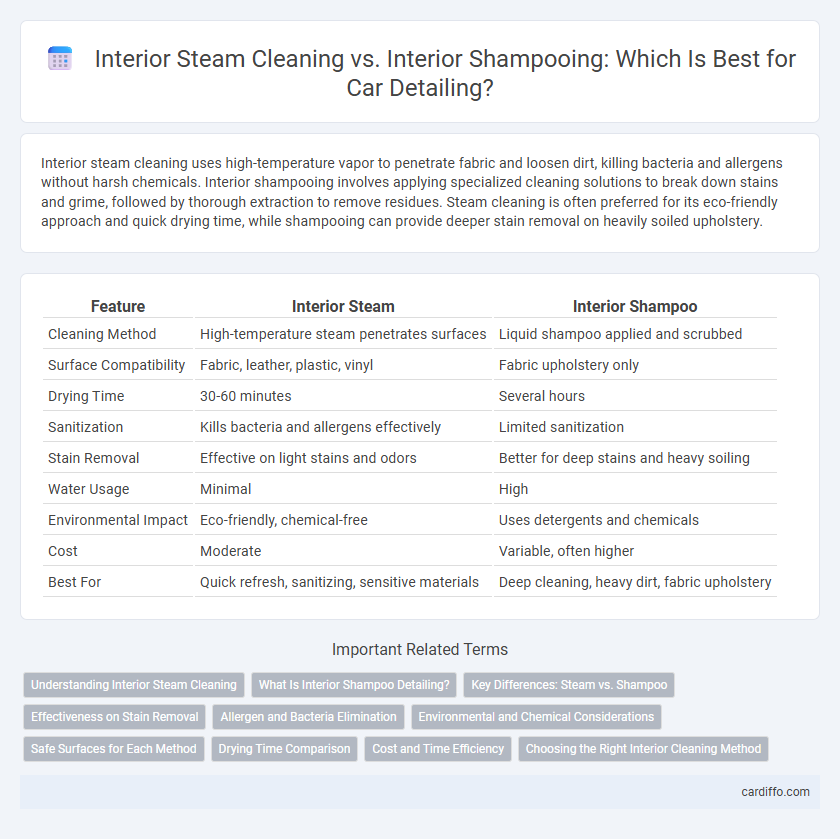Interior steam cleaning uses high-temperature vapor to penetrate fabric and loosen dirt, killing bacteria and allergens without harsh chemicals. Interior shampooing involves applying specialized cleaning solutions to break down stains and grime, followed by thorough extraction to remove residues. Steam cleaning is often preferred for its eco-friendly approach and quick drying time, while shampooing can provide deeper stain removal on heavily soiled upholstery.
Table of Comparison
| Feature | Interior Steam | Interior Shampoo |
|---|---|---|
| Cleaning Method | High-temperature steam penetrates surfaces | Liquid shampoo applied and scrubbed |
| Surface Compatibility | Fabric, leather, plastic, vinyl | Fabric upholstery only |
| Drying Time | 30-60 minutes | Several hours |
| Sanitization | Kills bacteria and allergens effectively | Limited sanitization |
| Stain Removal | Effective on light stains and odors | Better for deep stains and heavy soiling |
| Water Usage | Minimal | High |
| Environmental Impact | Eco-friendly, chemical-free | Uses detergents and chemicals |
| Cost | Moderate | Variable, often higher |
| Best For | Quick refresh, sanitizing, sensitive materials | Deep cleaning, heavy dirt, fabric upholstery |
Understanding Interior Steam Cleaning
Interior steam cleaning uses high-temperature steam to penetrate fabric fibers, effectively eliminating dirt, bacteria, and allergens without harsh chemicals. This method sanitizes surfaces, reduces odors, and refreshes upholstery while minimizing moisture, which helps prevent mold and mildew growth. Compared to interior shampooing, steam cleaning dries faster and maintains the vehicle's interior integrity by avoiding excessive water usage.
What Is Interior Shampoo Detailing?
Interior shampoo detailing is a deep-cleaning process that uses specialized foaming detergents to remove dirt, stains, and odors from fabric upholstery and carpets inside a vehicle. This method penetrates fibers to lift embedded grime and refresh the interior without causing damage. Interior shampoo detailing is essential for maintaining a clean, hygienic cabin environment and restoring fabric surfaces to their original appearance.
Key Differences: Steam vs. Shampoo
Interior steam cleaning uses high-temperature vapor to sanitize surfaces, effectively killing germs and loosening dirt without harsh chemicals. Interior shampooing involves applying a foamy detergent that penetrates fabric fibers to remove stains and odors but requires thorough drying to prevent mold. Steam cleaning offers a faster, eco-friendly option while shampooing provides deeper carpet and upholstery stain removal.
Effectiveness on Stain Removal
Interior steam cleaning penetrates fabric fibers with high-temperature vapor, effectively breaking down stubborn stains and killing bacteria without using harsh chemicals. Interior shampoo uses foaming detergents that lift dirt and grime from upholstery but may leave residue if not thoroughly extracted. Steam cleaning is generally more effective for deep stain removal and sanitization, ensuring a fresher and cleaner vehicle interior.
Allergen and Bacteria Elimination
Interior steam cleaning effectively eliminates allergens and bacteria by utilizing high-temperature steam that penetrates deep into fabric fibers, killing dust mites, mold spores, and germs without harsh chemicals. In contrast, interior shampooing relies on liquid detergents that may leave residue, potentially trapping allergens and promoting bacterial growth over time. Steam cleaning offers a superior hygienic solution for vehicle interiors, ensuring a cleaner, healthier environment by thoroughly sanitizing surfaces and reducing allergen presence.
Environmental and Chemical Considerations
Interior steam cleaning uses high-temperature vapor to sanitize surfaces, reducing the need for harsh chemicals and minimizing environmental impact. Interior shampooing often involves chemical detergents that can release volatile organic compounds (VOCs), posing risks to indoor air quality and increasing environmental pollution. Opting for steam cleaning enhances eco-friendly practices by lowering chemical usage and promoting safer, non-toxic vehicle interiors.
Safe Surfaces for Each Method
Interior steam cleaning is safe for delicate surfaces like leather, vinyl, and fabric upholstery as it uses high-temperature steam that sanitizes without harsh chemicals, reducing the risk of damage. Interior shampoo involves applying foamy detergents suitable for fabric seats and carpets but can potentially harm sensitive materials like leather or suede if not properly rinsed and dried. Choosing the right method depends on surface type, with steam cleaning preferred for fragile interiors and shampooing ideal for deep fabric cleaning.
Drying Time Comparison
Interior steam cleaning dries faster than interior shampooing due to the minimal moisture used in steam cleaning, often requiring less than 30 minutes to dry completely. Interior shampooing saturates fabrics with water and detergents, extending drying time to several hours or even a full day depending on ventilation and material thickness. Faster drying with steam cleaning reduces the risk of mold and mildew growth, making it a more efficient option for interior detailing.
Cost and Time Efficiency
Interior steam cleaning offers a cost-effective and time-efficient solution by rapidly loosening dirt and grime with minimal water usage, reducing drying time compared to interior shampooing. Interior shampoo requires more labor-intensive scrubbing and longer drying periods, leading to higher labor costs and extended service duration.Choosing interior steam cleaning optimizes both budget and time without compromising interior cleanliness quality.
Choosing the Right Interior Cleaning Method
Interior steam cleaning effectively eliminates dirt, stains, and bacteria by using high-temperature vapor to sanitize fabric surfaces without harsh chemicals. Interior shampoo penetrates deep into upholstery fibers, loosening embedded grime and odors through specialized cleaning agents. Selecting the right method depends on fabric type, level of soiling, and sensitivities to moisture, with steam favored for delicate textiles and shampoo preferred for heavy-duty stain removal.
Interior Steam vs Interior Shampoo Infographic

 cardiffo.com
cardiffo.com